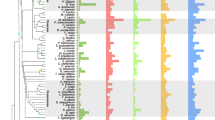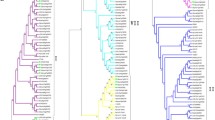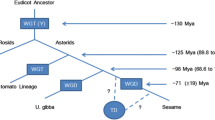Abstract
It is well known that nucleotide binding site (NBS)-encoding genes are duplicate-rich and fast-evolving genes. However, there is little information on the relative importance of tandem and segmental NBS duplicates and their exact evolutionary rates. The two rounds of large-scale duplication that have occurred in soybean provide a unique opportunity to investigate these issues. Comparison of NBS and non-NBS genes on segments of syntenic homoeologs shows that NBS-encoding genes evolve at least 1.5-fold faster (~1.5-fold higher synonymous and ~2.3-fold higher nonsynonymous substitution rates) and lose their genes ~twofold faster than the flanking non-NBS genes. Compared with segmental duplicates, tandem NBS duplicates are more abundant in soybean, suggesting that tandem duplication is the major driving force in the expansion of NBS genes. Notably, significant sequence exchanges along with significantly positive selection were detected in most tandem-duplicated NBS gene families. The results suggest that the rapid evolution of NBS genes may be due to the combined effects of diversifying selection and frequent sequence exchanges. Interestingly, TIR–NBS–LRR genes (TNLs) have a higher nucleotide substitution rate than non-TNLs, indicating that these types of NBS genes may have a rather different evolutionary pattern. It is important to determine the exact relative evolutionary rates of TNL, non-TNL, and non-NBS genes in order to understand how fast the host plant can adjust its response to rapidly evolving pathogens in a coevolutionary context.




Similar content being viewed by others
References
Akita M, Valkonen JP (2002) A novel gene family in moss (Physcomitrella patens) shows sequence homology and a phylogenetic relationship with the TIR–NBS class of plant disease resistance genes. J Mol Evol 55:595–605
Ameline-Torregrosa C, Wang BB, O’Bleness MS, Deshpande S, Zhu H, Roe B, Young ND, Cannon SB (2008) Identification and characterization of NBS–LRR genes in the model plant Medicago truncatula. Plant Physiol 146:5–21
Bailey TL, Elkan C (2005) The value of prior knowledge in discovering motifs with MEME. Proc Int Conf Intell Syst Mol Biol 3:21–29
Bakker EG, Toomajian C, Keritman M, Bergelson J (2006) A genome-wide survey of R gene polymorphisms in Arabidopsis. Plant Cell 18:1803–1818
Chen Q, Han Z, Jiang H, Tian D, Yang S (2010) Strong positive selection drives rapid diversification of R-genes in Arabidopsis relatives. J Mol Evol 70:137–148
Dangl JL, Jones JD (2001) Plant pathogens and integrated defence responses to infection. Nature 411:826–833
Deyoung BJ, Innes RW (2006) Plant NBS–LRR proteins in pathogen sensing and host defense. Nat Immunol 7:1243–1249
Ding J, Zhang W, Jing Z, Chen J-Q, Tian D (2007) Unique pattern of R-gene variation within populations in Arabidopsis. Mol Genet Genomics 277:619–629
Flor HH (1956) Mutations in flax rust induced by ultraviolet radiation. Science 124:888–889
Hayes AJ, Jeong SC, Gore MA, Yu YG, Buss GR, Tolin SA, Saghai Maroof MA (2004) Recombination within a nucleotide-binding-site/leucine-rice repeat gene cluster produces new variants conditioning resistance to soybean mosaic virus in soybeans. Genetics 166:493–503
Innes RW, Ameline-Torregrosa C, Ashfield T, Cannon E, Cannon CS et al (2008) Differential accumulation of retroelements and diversification of NB-LRR disease resistance genes in duplicated regions following polyploidy in the ancestor of soybean. Plant Physiol 148:1740–1759
Kuang H, Caldwell KS, Meyers BC, Michelmore RW (2008) Frequent sequence exchanges between homologs of RPP8 in Arabidopsis are not necessarily associated with genomic proximity. Plant J 54:69–80
Leister D (2004) Tandem and segmental gene duplication and recombination in the evolution of plant disease resistance genes. Trends Genet 20:116–122
Leister D, Kurth J, Laurie DA, Yano M, Sasaki T et al (1998) Rapid reorganization of resistance gene homologues in cereal genomes. Proc Natl Acad Sci USA 95:370–375
Li J, Ding J, Peng C, Zhang Y, Tang P, Chen JQ, Tian D, Yang S (2010) Unique evolutionary pattern of numbers of gramineous NBS–LRR genes. Mol Genet Genomic 283:427–438
Liu JJ, Ekramoddoullah AK (2003) Root-specific expression of a western white pine PR10 gene is mediated by different promoter regions in transgenic tobacco. Plant Mol Biol 52:103–120
Lupas A, Van Dyke M, Stock J (1991) Predicting coiled coils from protein sequences. Science 252:1162–1164
Lynch M, Conery JS (2000) The evolutionary fate and consequences of duplicated genes. Science 290:1151–1155
Lynch M, Crease TJ (1990) The analysis of population survey data on DNA sequence variation. Mol Biol Evol 7:377–394
Martin GB, Bogdanove AJ, Sessa G (2003) Understanding the functions of plant disease resistance proteins. Annu Rev Plant Biol 54:23–61
Meyers BC, Kozik A, Griego A, Kuang H, Michelmore RW (2003) Genome-wide analysis of NBS–LRR-encoding genes in Arabidopsis. Plant Cell 15:809–834
MGSC (2007) Medicago truncatula genome “Mt2.0” release whitepaper available at http://medicago.org/genome/downloads/Mt2/
Mondragon-Palomino M, Meyers BC, Michelmore R, Gaut B (2002) Patterns of positive selection in the complete NBS–LRR gene family of Arabidopsis thaliana. Genome Res 12:1305–1315
Nei M, Gojobori T (1986) Simple methods for estimating the numbers of synonymous and nonsynonymous nucleotide substitutions. Mol Biol Evol 3:418–426
Nobuta K, Ashfield T, Kim S, Innes RW (2005) Diversification of non-TIR class NB-LRR genes in relation to whole-genome duplication events in Arabidopsis. MPMI 18:103–109
Noël L, Moores TL, van Der Biezen EA, Parniske M, Daniels MJ, Parker JE, Jones JD (1999) Pronounced intraspecific haplotype divergence at the RPP5 complex disease resistance locus of Arabidopsis. Plant Cell 11:2099–2112
Ohno S (1970) Evolution by gene duplication. Allen & Unwin; Springer-Verlag, London
Pond SL, Frost SD, Muse SV (2005) HyPhy: hypothesis testing using phylogenies. Bioinformatics 21:676–679
Pond SL, Posada D, Gravenor MB, Woelk CH, Frost SDW (2006) Automated phylogenetic detection of recombination using a genetic algorithm. Mol Biol Evol 23:1891–1901
Rozas J, Sánchez-DelBarrio JC, Messeguer X, Rozas R (2003) DnaSP, DNA polymorphism analyses by the coalescent and other methods. Bioinformatics 19:2496–2497
Sato S, Nakamuta Y, Kaneko T, Asamizu E, Kato T et al (2008) Genome structure of the legume, Lotus japonicus. DNA Res 15:227–239
Schlueter JA, Lin JY, Schlueter SD, Vasylenko-Sanders IF, Deshpande S et al (2007) Gene duplication and paleopolyploidy in soybean and the implications for whole genome sequencing. BMC Genomics 8:330
Schmutz J, Cannon SB, Schlueter J, Ma J, Hyten DL et al (2010) Genome sequence of the palaeopolyploid soybean. Nature 463:178–183
Tamura K, Dudley J, Nei M, Kumar S (2007) MEGA4: Molecular Evolutionary Genetics Analysis (MEGA) software version 4.0. Mol Biol Evol 24:1596–1599
Tarr DE, Alexander HM (2009) TIR–NBS–LRR genes are rare in monocots: evidence from diverse monocot orders. BMC Res Notes 2:197
Thompson JD, Higgins DG, Gibson TJ (1994) CLUSTAL W: improving the sensitivity of progressive multiple sequence alignment through sequence weighting, position-speciWc gap penalties and weight matrix choice. Nucleic Acids Res 22:4673–4680
Tian D, Traw MB, Chen JQ, Kreitman M, Bergelson J (2003) Fitness costs of R-gene-mediated resistance in Arabidopsis thaliana. Nature 423:74–77
Van K, Kim DH, Cai CM, Kim MY, Shin JH et al (2008) Sequence level analysis of recently duplicated regions in soybean [Glycine max (L.) Merr.] genome. DNA Res 15:93–102
Yang S, Feng Z, Zhang X, Jiang K, Jin X, Hang Y, Chen JQ, Tian D (2006) Genome-wide investigation on the genetic variations of rice disease resistance genes. Plant Mol Biol 62:181–193
Yang S, Zhang X, Yue J-X, Tian D, Chen JQ (2008) Recent duplications dominate NBS-encoding gene expansion in two woody species. Mol Genet Genomics 280:187–198
Yi H, Richards EJ (2008) Phenotypic instability of Arabidopsis alleles affecting a disease resistance gene cluster. BMC Plant Biol 8:36
Zhang Y, Wang J, Zhang X, Chen JQ, Tian D, Yang S (2009) Genetic signature of rice domestication shown by a variety of genes. J Mol Evol 68:393–402
Acknowledgments
This work was supported by the National Natural Science Foundation of China (30930008, 30970198 and J0730641) and National Key Project for Gene Transform in China (2009ZX08009-27B). Two anonymous reviewers provided helpful comments.
Author information
Authors and Affiliations
Corresponding authors
Additional information
Communicated by Y. Van de Peer.
X. Zhang and Y. Feng contributed equally to this work.
Electronic supplementary material
Below is the link to the electronic supplementary material.
Rights and permissions
About this article
Cite this article
Zhang, X., Feng, Y., Cheng, H. et al. Relative evolutionary rates of NBS-encoding genes revealed by soybean segmental duplication. Mol Genet Genomics 285, 79–90 (2011). https://doi.org/10.1007/s00438-010-0587-7
Received:
Accepted:
Published:
Issue Date:
DOI: https://doi.org/10.1007/s00438-010-0587-7




